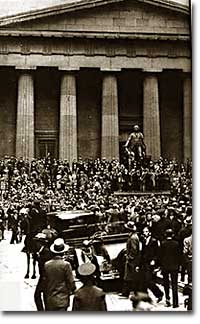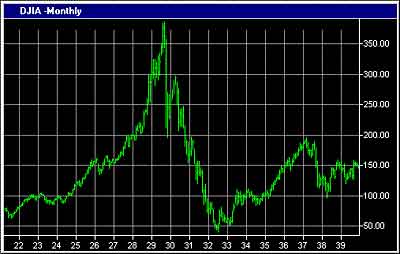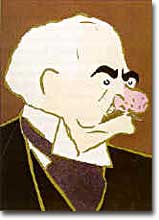48a. The Market Crashes

The Roaring '20s came to a screeching halt when the stock market took a historic nosedive at the end of the decade. Here, a nervous crowd gathers in front of the New York Stock Exchange on October 29, 1929.
It was a boom time for the stockholder. Stock prices soared to record levels. Millionaires were made overnight. Sound like the stock market of the 1990s? Try the New York Stock Exchange on the eve of the Great Crash in 1929.
Although the 1920s were marked by growth in stock values, the last four years saw an explosion in the market. In 1925, the total value of the New York Stock Exchange was $27 billion. By September 1929, that figure skyrocketed to $87 billion. This means that the average stockholder more than tripled the value of the stock portfolio he or she was lucky enough to possess.
In his Ladies' Home Journal article, "Everyone Ought to Be Rich," wealthy financier John J. Raskob advised Americans to invest just $15 dollars a month in the market. After twenty years, he claimed, the venture would be worth $80,000. Stock fever was sweeping the nation, or at least those that had the means to invest.
Fueling the rapid expansion was the risky practice of buying stock on margin. A margin purchase allows an investor to borrow money, typically as much as 75% of the purchase price, to buy a greater amount of stock. Stockbrokers and even banks funded the reckless speculator. Borrowers were often willing to pay 20% interest rates on loans, being dead certain that the risk would be worth the rewards. The lender was so certain that the market would rise that such transactions became commonplace, despite warnings by the Federal Reserve Board against the practice. Clearly, there had to be a limit to how high the market could reach.

On October 24, 1929, a day that came to be known as Black Thursday, investors began to sell their stocks at an alarming rate. By October 29, the Great Crash was underway, and by November 17, over $30 billion dollars had disappeared from the U.S. economy. In the chart above, the horizontal axis represents the years 1921-40, and the vertical axis represents the Dow Jones Industrial Average.
What causes stock prices to fall? Although the workings of the New York Stock Exchange can be quite complex, one simple principle governs the price of stock. When investors believe a stock is a good value they are willing to pay more for a share and its value rises. When traders believe the value of a security will fall, they cannot sell it at as high of a price. If all investors try to sell their shares at once and no one is willing to buy, the value of the market shrinks.

Wealthy investors like J.P. Morgan hoped to stop the crash by pooling their resources and buying up large amounts of stock.
On October 24, 1929, "Black Thursday," this massive sell-a-thon began. By the late afternoon, wealthy financiers like J.P. Morgan pooled their resources and began to buy stocks in the hopes of reversing the trend.
But the bottom fell out of the market on Tuesday, October 29. A record 16 million shares were exchanged for smaller and smaller values as the day progressed. For some stocks, no buyers could be found at any price. By the end of the day, panic had erupted, and the next few weeks continued the downward spiral. In a matter of ten short weeks the value of the entire market was cut in half. Suicide and despair swept the investing classes of America.





